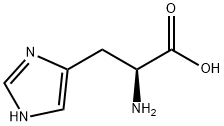Histamine dihydrochloride
Synonym(s):2-(4-Imidazolyl)ethylamine dihydrochloride
- CAS NO.:56-92-8
- Empirical Formula: C5H11Cl2N3
- Molecular Weight: 184.07
- MDL number: MFCD00012703
- EINECS: 200-298-4
- SAFETY DATA SHEET (SDS)
- Update Date: 2025-12-25 11:31:46

What is Histamine dihydrochloride?
Chemical properties
white powder
The Uses of Histamine dihydrochloride
Histamine dihydrochloride has been used:
- as a orthograde cotransmitter in producing excitatory postsynaptic potential (EPSP)
- to determine its level in fish using HPLC (high performance liquid chromatography)
- to assess the tracheal response to antigens in guinea-pigs
The Uses of Histamine dihydrochloride
Present in most mammalian tissues; primarily stored in mast cells and basophils. Exhibits multiple biological effects through at least 3 specific receptors. Induces bronchoconstriction and vasodilation; stimulates gastric acid secretion; and acts as a neurotransmitter.
The Uses of Histamine dihydrochloride
Histamine dihydrochloride has been shown to activate nitric oxide synthetase and suppress or inhibit the generation of reactive oxygen species (ROS). Inhibition of ROS by histamine dihydrochloride allows activation of T cells and NK cells by IL-2. In a rat model, histamine dihydrochloride suppressed ROS generated by Kupffer cells through the H2 histamine receptor. It is a potent vasodilator and endogenous histamine receptor agonist.
What are the applications of Application
Histamine dihydrochloride is a potent vasodilator and endogenous histamine receptor agonist
General Description
Histamine Dihydrochloride is a derivative of histamine, which is implicated in tumor cell apoptosis and prevents the relapse of acute myeloid leukemia in patients. It prevents the formation of ROS (reactive oxygen species) and inhibits the activation of T cells and natural killer cells.
Pharmaceutical secondary standards for application in quality control, provide pharma laboratories and manufacturers with a convenient and cost-effective alternative to the preparation of in-house working standards.
Biological Activity
Endogenous agonist at histamine receptors (H 1-4 ). Released from mast cells and basophils and exhibits inflammatory, vasodilatory and bronchoconstrictory activity. Stimulates gastric acid secretion and acts as a neurotransmitter in vivo .
Biochem/physiol Actions
Histamine dihydrochloride has been shown to activate nitric oxide synthetase and suppress or inhibit the generation of reactive oxygen species (ROS). Inhibition of ROS by histamine dihydrochloride allows activation of T cells and NK cells by IL-2. In a rat model, histamine dihydrochloride suppressed ROS generated by Kupffer cells through the H2 histamine receptor.
Storage
Room temperature (desiccate)
Purification Methods
The dihydrochloride crystallises from aqueous EtOH. The phosphate (2H3PO4) [51-74-1] has m 132-133o (from H2O). [Beilstein 25 III/IV 2049.]
Properties of Histamine dihydrochloride
| Melting point: | 249-252 °C(lit.) |
| storage temp. | 2-8°C |
| solubility | H2O: 0.1 g/mL, clear, colorless |
| form | powder |
| color | white to off-white |
| Water Solubility | SOLUBLE |
| Merck | 14,4719 |
| BRN | 3624116 |
| Stability: | Stable. Incompatible with strong oxidizing agents. |
| CAS DataBase Reference | 56-92-8(CAS DataBase Reference) |
| EPA Substance Registry System | 1H-Imidazole-4-ethanamine, dihydrochloride (56-92-8) |
Safety information for Histamine dihydrochloride
| Signal word | Danger |
| Pictogram(s) |
 Exclamation Mark Irritant GHS07  Health Hazard GHS08 |
| GHS Hazard Statements |
H315:Skin corrosion/irritation H317:Sensitisation, Skin H319:Serious eye damage/eye irritation H334:Sensitisation, respiratory H335:Specific target organ toxicity, single exposure;Respiratory tract irritation |
| Precautionary Statement Codes |
P280:Wear protective gloves/protective clothing/eye protection/face protection. P302+P352:IF ON SKIN: wash with plenty of soap and water. P305+P351+P338:IF IN EYES: Rinse cautiously with water for several minutes. Remove contact lenses, if present and easy to do. Continuerinsing. |
Computed Descriptors for Histamine dihydrochloride
| InChIKey | PPZMYIBUHIPZOS-UHFFFAOYSA-N |
Histamine dihydrochloride manufacturer
JSK Chemicals
New Products
Indole Methyl Resin tert-butyl 9-methoxy-3-azaspiro[5.5]undecane-3-carboxylate Boc-His(Boc)-OH 2-CTC Resin 4-Chloro-7-tosy1-7Hpyrrolo[2,3-d]pyrimidine 5,7-Dibromo-1H-indole 2,5-dichloro-N-hydroxy-4,6-dimethylpyridine-3-carboximidamide 2,2-Dimethoxy-7-azaspiro[3.5]nonane hydrochloride 4-chloromethyl-5-methyl-1,3-dioxol-2-one (DMDO-Cl) R-2-BENZYLOXY PROPIONIC ACID 1,1’-CARBONYLDIIMIDAZOLE 1,1’-CARBONYLDI (1,2-4 TRIAZOLE) N-METHYL INDAZOLE-3-CARBOXYLIC ACID 4-((2-hydroxyethyl)thio)benzoic acid 1-(TERT-BUTOXYCARBONYL)-2-PYRROLIDINONE Methyl 6-methylnicotinate 3-Pyridineacrylic acid tert-Butyl carbazate TETRAHYDRO-2H-PYRAN-3-OL 2-((4-morpholinophenylamino) (methylthio) methylene) malononitrile 3-(4-morpholinophenylamino)-5-amino-1H-pyrazole-4-carbonitrile 2,4-dihydroxybenzaldehyde 1,3-Diethyl-1,3-Diphenylurea Methyl 2-methylquinoline-6-carboxylateRelated products of tetrahydrofuran








You may like
-
 Histamine dihydrochloride, 99% 99%View Details
Histamine dihydrochloride, 99% 99%View Details
56-92-8 -
 Histamine dihydrochloride CAS 56-92-8View Details
Histamine dihydrochloride CAS 56-92-8View Details
56-92-8 -
 Histamine hydrochloride CAS 56-92-8View Details
Histamine hydrochloride CAS 56-92-8View Details
56-92-8 -
 Histamine Dihydrochloride (HSM) CAS 56-92-8View Details
Histamine Dihydrochloride (HSM) CAS 56-92-8View Details
56-92-8 -
 Histamine DiHCl 98% CAS 56-92-8View Details
Histamine DiHCl 98% CAS 56-92-8View Details
56-92-8 -
 Histamine Dihydrochloride CAS 56-92-8View Details
Histamine Dihydrochloride CAS 56-92-8View Details
56-92-8 -
 Histamine dihydrochloride CAS 56-92-8View Details
Histamine dihydrochloride CAS 56-92-8View Details
56-92-8 -
 HISTAMINE DIHYDROCHLORIDE For Biochemistry CAS 56-92-8View Details
HISTAMINE DIHYDROCHLORIDE For Biochemistry CAS 56-92-8View Details
56-92-8
